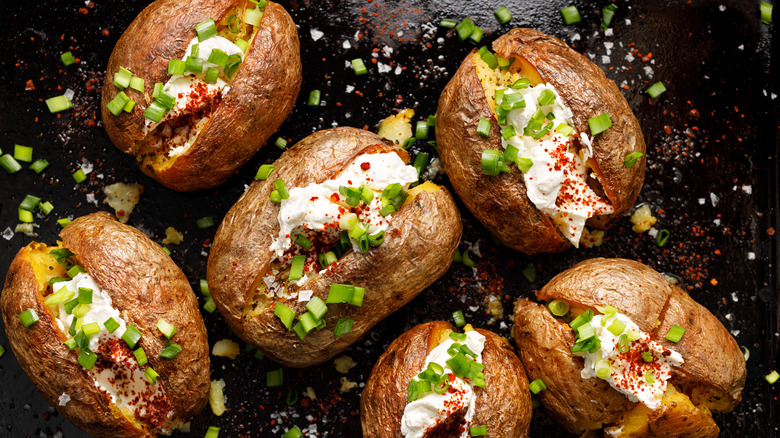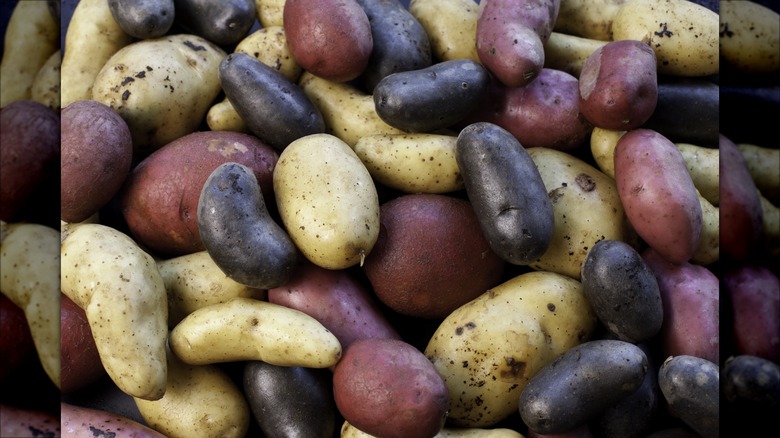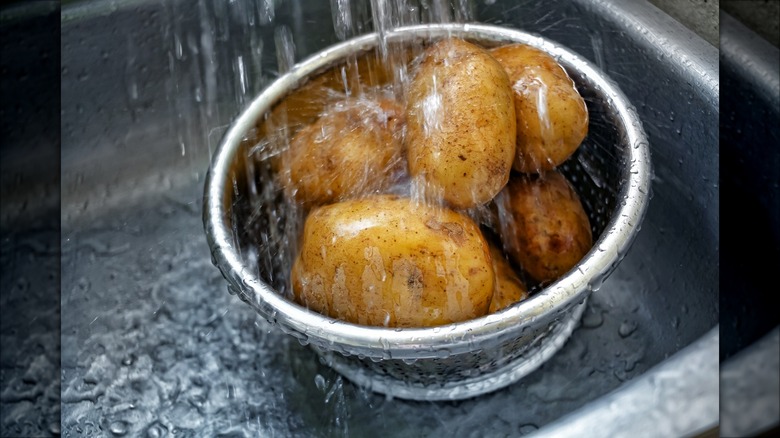You Should Skip The Aluminum Foil When Baking Potatoes
The easiest approach to baking potatoes is also the least expensive and least time-consuming way to do it: Just scrub them under running water, dry them with a dishcloth, use a fork to poke them with a few holes in a cross pattern, then bake at 450 degrees Fahrenheit for 45 minutes. That's it!
Restaurants long ago abandoned the practice of wrapping potatoes in aluminum foil before baking (and so should you) because doing so adds unnecessary time and expense, and we think produces a less appetizing result. Where foil cooking tends to give you pale, flabby skin, skipping the foil will make the skin of your tuber pleasantly crisp, and worthy of eating rather than just peeling away.
Despite the potato's fleshy nature, it is comprised of about 80% water, and cooking potatoes in foil does not cause them to cook faster, it just creates a sauna that steams it. So banish the thought of treating the skin as a castoff while consuming only the white or yellow flesh. Not only will this rob you of the most nutrient-dense part of the potato, but you'll miss out on that amazing flavor as well.
Start with the right potato
Baked potato prep begins at the grocery store or farmers' market. For baking, choose potatoes individually from a display instead of purchasing a bag of potatoes and relying on luck of the draw. Starchy, not waxy, potatoes are the ones you want — russet potatoes being the ideal choice given their combination of low moisture to high starch. The second tier 'tater is Idahos, which are a bit less starchy, but still relatively low in moisture. Very waxy and moisture-retaining potatoes, like Yukon Golds, should only be used as a last resort. But no matter the potato variety you choose, leave that foil in the cabinet.
It's best to select potatoes that are smooth and evenly textured without wrinkles, shatter patterns, splotches of green skin, eyes (deep spots), scales, or sprouts. Store the potatoes in a cool, dark place. Your refrigerator will be a bit too cold and the kitchen counter too warm. If you have a root cellar with a temperature range of 45 to 50 degrees Fahrenheit this is an ideal place to store potatoes, otherwise, use your kitchen pantry.
Get baking
Once they reach the kitchen, wash and dry your potatoes thoroughly. Wet potatoes will result in excess steam, which is exactly what we are trying to avoid. Use a fork to poke holes to allow moisture to escape the potatoes while cooking. For enhanced flavor, chefs and restaurateurs often brine their potatoes in salt water, sometimes adding sprigs of herbs, such as rosemary, to the brine. Potatoes should be brined for at least 20 minutes, but overnight is fine too.
Once (brined if you like), dried, and poked, put the potatoes on a baking sheet lined with aluminum foil and fitted with a wire rack to ensure even cooking and catch any drippings. To ensure success, you can even use an instant-read thermometer; if your potato comes in at 205 to 212 degrees Fahrenheit you have hit the sweet spot. The last step — and this should be done as soon as the potatoes come out of the heat — is to cut the potato halfway through from top to bottom then push the top and bottom toward the center so the potato opens well up and steam can quickly escape.


